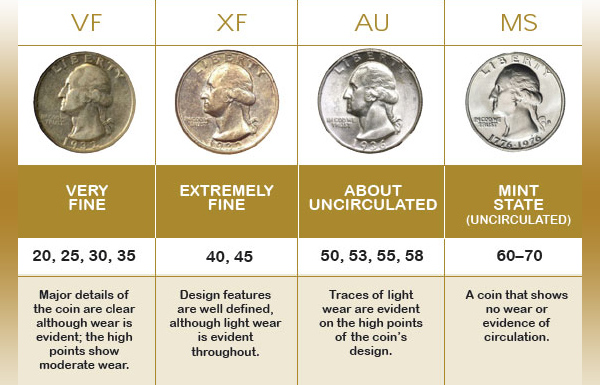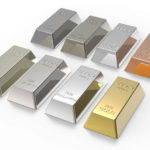Understanding the Point Grading Scale
The table below shows each of the point scores on the modern Point Grading Scale along with their corresponding descriptive categories and abbreviations, and is followed by a list of detailed category explanations and defining characteristics.
Note: The Difference between Mint State and Proof Grades
The term “Mint State” is a grader’s designation for a regular Business Strike coin that has never been circulated: e.g. one in the same approximate condition as when it was first produced. A Mint State (MS) coin is graded between 60 (with marks) and 70 (flawless/gem-like)—the highest grade a Business Strike coin can achieve.
The Brilliant Uncirculated designation (BU) is reserved for Business Strike coins that have never been circulated (e.g. that are in Mint State) and fall in a grade range of roughly 60-63. As BU coins are rarely valued at a high enough price point to merit the cost of sending them to a grading company, they are typically sold in rolls of 20.
Proof coins are hardly ever used in circulation. A Proof is struck in the same manner as a Business Strike coin but with the addition of a special die preparation with polish to enhance its shine and reflectivity. Proofs are made primarily for collectors. As such, these high value investment coins are graded in their own separate category (PF or PR 60-70) and are typically placed in a protective cover to preserve their exceptional worth and beauty.
The Point Grading Scale
| POINT SCORE | CATEGORY | EXAMPLE OF GRADE WRITTEN ON HOLDER |
||
| 1 | = | Poor (or Basal) | (P) | P1 |
| 2 | = | Fair | (F) | F2 |
| 3 | = | Almost Good | (AG) | AG3 |
| 4 & 6 | = | Good | (G) | G4 |
| 8 & 10 | = | Very Good | (VG) | VG10 |
| 12 & 15 | = | Fine | (F) | F12 |
| 20, 25, 30, 35 | = | Very Fine | (VF) | VF30 |
| 40 & 45 | = | Extremely Fine | (EF) | EF45 |
| 50, 53, 55, 58 | = | Almost Uncirculated | (AU) | AU55 |
| 60-64 | = | Mint State Choice | (MS) | MS63 |
| 65-70 | = | Mint State Gem | (MS) | MS66 |
| 60-70 | = | Proof | (PF OR PR) | PR65 |
| (Proof Coins Only) | ||||
Coin Categories Explained
Poor (Basal) - A coin graded Poor is badly damaged or worn smooth to the point that the type is barely legible. Little to no other details are recognizable.
Fair – This grade is similar to Poor, connoting severe damage and wear, except that, in addition to the type, the date is now also barely identifiable.
About Good – The type and date of an About Good coin are both distinguishable, though worn out in spots. Some additional lettering is apparent, though not necessarily readable.
Good - Despite overall heavy wear, the major devices and features of a Good coin are recognizable in their outlines.
Very Good – A Very Good coin has a full rim with clearly discernable devices and features. Most of the legends are easily readable, despite overall significant wear.
Fine – Similar to a grade of Very Good in terms of legibility and detail (e.g. a clearly defined rim, readable legends, and clear devices showing some detail), a grade of Fine implies more moderate, but still evenly distributed wear.
Very Fine – A Very Fine grade indicates still moderate, though less consistent wear—some around the high points and a little below. The coin has clearly readable but lightly worn legends. The devices show good detail, and the rims are clean.
Extremely Fine – Despite slight but obvious wear, now more limited to the high points, the legends of an Extremely Fine coin are sharp, and the devices, clear. This grade implies the first hints of real eye appeal.
About Uncirculated - Sharp legends and devices show only a trace of wear on the high points. About Uncirculated coins still possess at least 50% of their original mint luster, resulting in great eye appeal.
Mint State (Choice) 60 to 64 – Business strike coins of this grade typically retain much of their original luster and are considered to be in mint condition (free of wear). Primarily, minor of blemishes, such as bag marks or ill-toning, prevent these remarkable specimens from obtaining the highest grades.
Mint State (Gem) 65 to 70 – These coins are considered gem quality and are typically quite lustrous. Each higher grade reflects things such as fewer bag-marks or sharper details, up to the grade of MS70, which is considered perfect (zero marks and no ill-toning).
Proof – Proof designations pertain only to Proof Coins and are based primarily on eye appeal, quality of luster, and the presence or absence of contact marks, hairlines, etc.
What is PLUS (+) Grading
Beginning in 2010, PCGS and NGC (the two largest and arguably the most respected grading services in the industry) added a PLUS feature to the numismatic grading scale. The PLUS grade helps distinguish the highest quality coins in any given grade. For example, in addition to seeing coins graded MS65, you will also now find coins graded MS65+.
The PLUS grade indicates to investors, collectors, and coin dealers that a coin is of higher quality than it’s similarly graded counterparts. PLUS coins sit at the top 20-30% of their grade. Since a PLUS grade indicates the highest quality coins of a particular grade, PLUS graded coins can (and usually do) command an additional premium over standard graded coins in that same grade.







